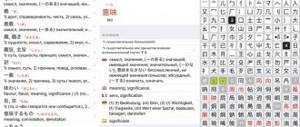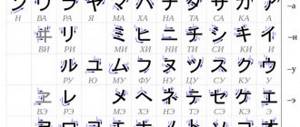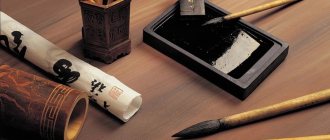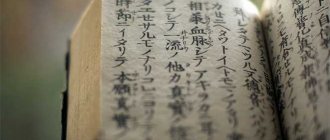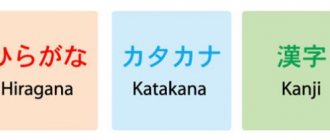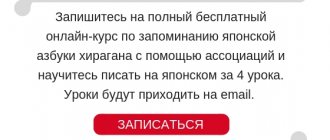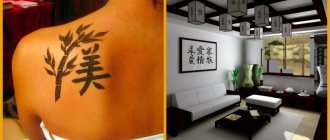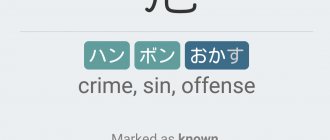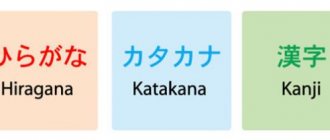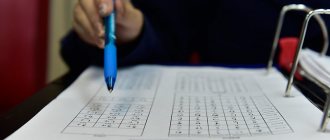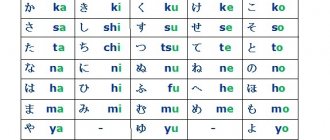At the beginning of studying, Japanese numbers raise many questions, since they have different pronunciations, Japanese proper, which is pronounced according to the kun reading of the hieroglyph, and Chinese, pronounced according to the on reading of the hieroglyph. Learning numbers is not difficult, the main thing is to remember in which case the kun or on reading is used.
Also, some numbers have two pronunciations - all that remains is to learn and remember in which combination this or that sound of the hieroglyph is pronounced.
Below are tables of abstract counting without application to days, years, number of items, etc. It's like we do when we just count to ten: one, two, three, four, five and so on. In this case, the Chinese pronunciation (on) is used.
Numerals in Japanese
Abstract counting numbers from zero to ten
| Number | Hieroglyph | Hiragana (on sound) | Pronunciation (romaji) | Meaning |
| 0 | 零 | ゼロ、れい | zero, rei | zero |
| 1 | 一 | いち | ichi | one |
| 2 | 二 | に | ni | two |
| 3 | 三 | さん | san | three |
| 4 | 四 | し、よん | shi、yon | four |
| 5 | 五 | ご | go | five |
| 6 | 六 | ろく | roku | six |
| 7 | 七 | しち、なな | shichi、nana | seven |
| 8 | 八 | はち | hachi | eight |
| 9 | 九 | く、きゅう | ku、kyu: | nine |
| 10 | 十 | じゅう | ju: | ten |
A children's video will help you, you will not only remember the pronunciation of numbers from 0 to 10, but also hear how the Japanese do it, since in some numbers (including in subsequent digits) the sound is reduced or lengthened. It's always useful to hear the pronunciation of a native speaker.
Question
– こ ko の no 部 he 屋 ya に ni は wa い i す su が ga い i く ku つ tsu あ a り ri ま ma す s か ka 。
– 4 yo つ ttsu あ a り ri ま ma す s 。
It is also possible that instead of the question word い i く ku つ tsu the following construction is used: 何 nani,nan + counting word
. The choice of which construction to ask the question is yours.
– 子 ko 供 domo は wa 何 nan 人 nin い i ま ma す su か ka 。 – How many children?
– 3 san 人 nin い i ま ma す su 。 – We have 3 children.
In answering a question, no matter what the question word was, a question word will be used next to the numeral.
自 ji 動 dou 車 sha は wa 何 nan 台 dai あ a り ri ま ma す su か ka 。 二 ni 台 dai あ a り ri ま ma す su 。 – How many cars do you have? We have 2 cars.
コ ko ン m ピ py ュ u ー u タ ta ー a は wa 何 nan 台 dai あ a り ri ま ma す su か ka 。 四 yon 台 dai で de す su 。– How many computers do you have. I have 4 computers.
How much does a ticket cost? Ticket costs 100 yen.
冷 rei 蔵 zou 庫 ko に ni ビ bi ー i ル ru は wa 何 nan 本 bon あ a り ri ま ma す su か ka 。 三 san 本 bon で de す su 。– How many bottles of beer are in the refrigerator e? 3 bottles of beer.
Source
Numbers from 10 in Japanese
Japanese numbers after 10 are easy to remember; just learn the first ten. Each subsequent number is the result of adding 10 and the desired digit. So 11 is 10+1, in Japanese it looks like this:十i一 / じゅう + いち / ju:ichi
| Number | Hieroglyph | Hiragana (on sound) | Pronunciation (romaji) | Meaning |
| 11 | 十一 | じゅういち | ju: ichi | eleven |
| 12 | 十二 | じゅうに | ju:ni | twelve |
| 13 | 十三 | じゅうさん | ju: san | thirteen |
| 14 | 十四 | じゅうし じゅうよん | ju: shi ju: yon | fourteen |
| 15 | 十五 | じゅうご | ju: go | fifteen |
| 16 | 十六 | じゅうろく | ju: roku | sixteen |
| 17 | 十七 | じゅうしち じゅうなな | ju: shichi ju: nana | seventeen |
| 18 | 十八 | じゅうはち | ju:hachi | eighteen |
| 19 | 十九 | じゅうきゅう じゅうく | ju:kyu:ju:ku | nineteen |
| 20 | 二十 | にじゅう | ni ju: | twenty |
Japanese account
The Japanese themselves use both their own traditionally Japanese and Arabic numerals. As a rule, if numbers and text are written in a vertical direction, then the Japanese version is used, but if they are written in a horizontal direction, then Arabic numerals are more often used.
To count objects, the Japanese use their own version of reading numbers, called kun. In this case, a special suffix is added to each numeral to designate exactly the object that is being counted. This counting system is quite complex, I will not present it here, since it is not used in karate during training. However, we also encounter it in the first words of the Kyokushinkai oath.
Kyokushinkai karate uses the Chinese-Japanese number system - Kanji. Below we will talk about it.
Counting tens in Japanese
As you noticed above, tens in Japanese are obtained as follows: first we call the desired number and add 10 to it. Visually it looks like this - 2 * 10 = 20 /二and十 / に and じ ゅう
| Number | Hieroglyph | Hiragana (on sound) | Pronunciation (romaji) | Meaning |
| 10 | 十 | じゅう | ju: | ten |
| 20 | 二十 | にじゅう | niju: | twenty |
| 30 | 三十 | さんじゅう | sanju: | thirty |
| 40 | 四十 | しじゅう よんじゅう | shiju: yonju: | fourty |
| 50 | 五十 | ごじゅう | goju: | fifty |
| 60 | 六十 | ろくじゅう | rokuju: | sixty |
| 70 | 七十 | しちじゅう ななじゅう | shichiju: nanaju: | seventy |
| 80 | 八十 | はちじゅう | hachiju: | eighty |
| 90 | 九十 | きゅうじゅう | kyu:ju: | ninety |
| 100 | 百 | ひゃく | hyaku | one hundred |
Remember:
- 九十 / きゅうじゅう / kyu: ju: / ninety
In this combination there is only one pronunciation; you cannot use the second meaning of the number 9 (ku)
What will the number 38 look like? Correct: 3*10+8,三十八/さんじゅうはち/sanju: hachi,
In this video you can get acquainted with Japanese numbers from the smallest to the very largest. It may be difficult to understand everything the first time, but once you master Japanese counting, in my opinion, this video is very informative.
If you want to know which counting suffix you need to use when talking about animals, books or other objects, then read the article counting suffixes in Japanese.
Interesting to know
In Japan, the numbers 4 and 9 are considered unlucky. Four is pronounced "shi", which is similar to the Japanese word for "death". Therefore, very often the pronunciation of “shi” is changed to “yong”. Nine, in turn, is consonant with the word "suffering", which is pronounced simply as "ku". Therefore, you can often hear a modification of the pronunciation of the number 9.
In modern Japanese, all numbers except 4 and 7 have Chinese pronunciation (that is, they are read as “onna”). But in the names of the months, even they are pronounced with “OH”.
Numbers in Japanese from 100
We learned above that 100 in Japanese is read as百/ひゃく/ hyaku. The hundreds place is formed by combining百with the digit we need. So the number 500 is the product of 5 and 100, that is, we take the number 5五/ご/ go and add百/ひゃく / hyaku =五百 /ごひゃく / gohyaku.
At the same time, in the category of hundreds, as well as in the category of thousands, new rules for stunning, voicing and doubling sounds appear; this must be remembered!
- 300 would sound like さんびゃく / san b yaku
- 400 only as よんひゃく / yon hyaku
- 600 – ろっぴゃく / ropp yaku
- 700 – ななひゃく / nana hyaku
- 800 – はっぴゃく / happ yaku
If you need to say one hundred, then there is also a change in pronunciation:一百 / いっぴゃく / ippyaku
| Number | Hieroglyph | Hiragana (on sound) | Pronunciation (romaji) | Meaning |
| 100 | 百 | ひゃく | hyaku | one hundred |
| 200 | 二百 | にひゃく | nihyaku | two hundred |
| 300 | 三百 | さんびゃく | sanbyaku | three hundred |
| 400 | 四百 | よんひゃく | yonhyaku | four hundred |
| 500 | 五百 | ごひゃく | gohyaku | five hundred |
| 600 | 六百 | ろっぴゃく | roppyaku | six hundred |
| 700 | 七百 | ななひゃく | nanahyaku | seven hundred |
| 800 | 八百 | はっぴゃく | happyaku | eight hundred |
| 900 | 九百 | きゅうひゃく | kyu:hyaku | nine hundred |
| 1000 | 千 | せん | sen | thousand |
The number 777 in Japanese will look like this: 七百七十七 / ななひゃくななじゅうなな /nanahyaku nanaju: nana
Number 357 - 三百五十七 / さんびゃくごじゅうなな / sanbyaku goju: nana
Japanese numbers
Japanese numbers
In Japanese, the counting system is divided into units, tens, hundreds, thousands, tens of thousands (class "mans"), hundreds of millions.
Unlike European languages, numbers greater than 10 thousand are divided into 4 categories: units, tens, hundreds, thousands.
In translation, 10 thousand is called 万/man/ man, i.e. all subsequent numbers will be designated as “man”.
Starting from 100 million, the count goes to “oku” 億 – 100 million. Ten thousand "oku" (one trillion) and then counted as 兆/cho:/ "cho:". If in Russian large numbers look like 000 000, then in Japanese they are 0000 0000.
The Japanese language also uses the European spelling of numbers, the use of commas, and writing numbers in Arabic numerals. To memorize the Japanese counting system, you need to rebuild the table of large numbers as follows (click on the table to enlarge):
As can be seen from the table, the spelling in Russian and Japanese is different, which is the subject of certain difficulties.
It is best to easily master reading and translation skills, try to separate 4 digits from the end, and not 3 digits, as in Russian, then translate as written below:
4.897 – 四千八百九十七 / YONSEN HAPPYAKU KYU:JU: NANA
95.378 (9.5378) – 九万五千三百七十八 / KYU:MAN GOSEN SANBYAKU NANAJU: HACHI
176.243 (17.6243) – 十七万六千二百四十三/ JU:NANAMAN ROKUSEN NIHYAKU YONJU:SAN
3.546.829 (354.6829) – 三百五十四万六千八百二十九/ SANBYAKU GOJU: YONMAN ROKUSEN HAPPYAKU NIJU: KYU:
21.496.276 (2149.6276) – 二千百四十九万六千二百七六/ NISEN HYAKU YONJU: KYU:MAN ROKUSEN NIHYAKU NANAJU: ROKU
314.024.590 (3.1402.4590) – 三億千四百二万四千五百九十/ SAN OKU SEN YONHYAKU NIMAN YONSEN GOHYAKU KYU: JU:.
Another point of difficulty is when the number is written in numbers and hieroglyphs at the same time.
For ease of translation, after the character 万/man add 4 zeros, and if senman / 千万 – 7 zeros, then you get the required number:
48万/ YONJU: HACHIMAN = 48+0000 → 480,000 (480 thousand)
250万/ NIHYAKU GOJU:MAN = 250 + 0000 → 2,500,000 (2 million 500 thousand)
2,600万/ NISEN ROPPYAKU MAN = 2,600 + 0000 → 26,000,000(26 million)
3千万/ SANZEN MAN – 3 + 0000000 → 30,000,000 (30 million)
1億2千万/ ICHIOKU NISEN MAN – 100,000,000 + 2 + 0000000 → 120,000,000 (120 million)
Try writing your numbers in Japanese in the comments below! Test yourself!
When using this article on other resources, an active link to the site is required.
This is a useful read:
- Japanese language. Feedback from subscribers
- Invitation to participate in 3 online Japanese lessons for free
- Possibility of taking action
Tagged katakana Japanese language courses counting in Japanese hiragana numbers in Japanese Japanese language school Japanese language Japanese language for beginners Japanese language from scratch
Counting in Japanese - thousands
The principle of compiling numbers is the same as before, a thousand is added to the number, you just need to remember some features.
- 3000 – さんぜん / san dz en
- 4000 - よんせん / yon sen
- 7000 - ななせん / nana sen
- 8000 — はっせん/ hass en
| Number | Hieroglyph | Hiragana (on sound) | Pronunciation (romaji) | Meaning |
| 1000 | 千 | せん | sen | thousand |
| 2000 | 二千 | にせん | nisen | two thousand |
| 3000 | 三千 | さんぜん | sandzen | three thousand |
| 4000 | 四千 | よんせん | yonsen | four thousand |
| 5000 | 五千 | ごせん | gosen | five thousand |
| 6000 | 六千 | ろくせん | rokusen | six thousand |
| 7000 | 七千 | ななせん | nanasen | seven thousand |
| 8000 | 八千 | はっせん | hassen | eight thousand |
| 9000 | 九百 | きゅうせん | kyu:sen | nine thousand |
| 10000 | 万 | まん | man | ten thousand |
The number 1094 in Japanese will look like this: 千九十四 / せんきゅうじゅうよん / sen kyu: ju: yon
Number 6890 - 六千八百九十 / ろくせんはっぴゃくきゅうじゅう / rokusenhappyakukyu:ju:
Agree that the Japanese language is not so difficult that you refuse to study it, but it is very interesting and melodic that you decide to take a step towards understanding it. You will begin to think differently, learning any foreign language broadens your horizons, and the Japanese language is special in this regard, familiarity with grammar will help you better understand the mentality of the Japanese, different styles of speech will tell you about the versatility of relationships in Japanese society. Certified teacher, simultaneous interpreter Anna Reva and the online Japanese language school “Ikigai” will help you take an interesting path in learning the Japanese language.
Pay off the first or third!
Japanese numerals are very easy to remember. And if you learn the numbers from 1 to 12, then you don’t have to bother with memorizing the months of the year. In Japan they have no names. Simply add the word “gatsu” to the number that indicates the month number. For example, January will sound like “Ichigatsu,” which literally means “first month.” It is worth paying attention to the fourth and seventh months. When it comes to months, the “exceptional” ones—April and July—are pronounced “in Chinese,” that is, with “on” pronunciation. The result will be:
- 四月 – Shigatsu (April).
- 七月 – Shichigatsu (July).
Interest in Japan is inevitable. Traditions, language, mentality, culture - all this attracts the attention of the public. After all, there, in the country where the sun wakes up earlier, everything is different. Even the numbers are not the same as everyone else’s. This is what makes Japan interesting. Difficult, but interesting.
Japanese numerals
Next, let's look at the list of Japanese numerals. There are only ten of them and they are preserved from the old Japanese language. Previously, one in Japanese sounded like “hi”, two - “fu”, three - “mi” and so on. Japanese numerals are used in certain cases, such as:
- when you need to say the number of the month from one to ten. For example, April 2 will be 4月二日/しがつ ふつか/ shi gatsu futsuka
- when you need to say the number of days (from 1 to 10) expressing a period of time. For example: 3 days -三日/みっか/ mikka
- when indicating the number of small items (cake, bag, chair, etc.)
- when ordering
- when indicating age (unless a counting suffix indicating age さい is used), etc.
You can use the following hint: if the wordいくつ/ ikutsu / how much? is used in an interrogative sentence, then the answer must use numerals of Japanese origin. If the question consists of the Chinese (on) version of the reading 何 / なん、なに / nan, nani / question word - what?, how many, then the numbers given in the tables above are used.
More than a hundred
Japanese numbers are formed by adding one numeral to another. Even hundreds are formed in this way. 100 (百) is pronounced "hyaku" in Japanese. To form the numerals 300, 400, etc., you must pronounce the name of the corresponding number from the first table before “hyaku”. Here are some examples:
- 300 (三百) – Sanhyaku.
- 400 (四百) – Yonhyaku.
- 500 (五百) – Gohyaku.
Almost no one has any difficulties with this question. The fun begins when you need to pronounce a three-digit number, which is not in the examples. For example, 125. In theory, it is clear that all the numerals that make up the number must be added together, but in practice many are lost. 125 would sound like "hyakuninjugo" in Japanese. If you write the number using kanji (hieroglyphs), then you get 百二十五. That is, 125 is the sum of the numbers: 100+20+5.
The numbers 1000 and 10000 are denoted as:
- 千 – Sen (thousand).
- 万 – Man (ten thousand).
The numbers are formed in exactly the same way as the previous groups of numbers. For example, 1367 Japanese numbers translated into Russian will sound like “sen (1000) sanhyaku (300) rokujunana (67).” In this way, you can easily form numbers until you need to say a million.
Perhaps this is an exception to the rule. If six-digit numbers are formed by combining numbers of previous orders (“juni” or “niju”), then a million is formed using the numbers 100 and 10,000. Accordingly, 1,000,000 will sound like “Hyakuman”.
Tutor or language school
When asked where to start learning Japanese from the very beginning, experts recommend using recorded Japanese audio lessons. There are quite a lot of them on the Internet, and everyone can choose the right option for themselves. This format will allow you to master the basics of Japanese, and then move on to a more complex level.
If you have more serious tasks ahead of you, for example, you are going to live or work in Japan, then you will not be able to avoid language courses.
You can enroll in a language school or take classes online. This format will not only allow you to learn useful phases, but will also teach you how to read and write in Japanese. With the help of qualified teachers, the language learning process will become correct, organic and effective.
The beginning of any lesson will be the study of the alphabet (katakana and hiragana). In two weeks you can master this material, knowledge of which will later allow you to write down phrases and sentences. This is an important stage, without which further work on learning the language is impossible.
Learning Kanji characters is much more difficult, but if you want to know the language perfectly, then it is worth your time. To learn Kandi, you should use flashcards designed for this purpose.
